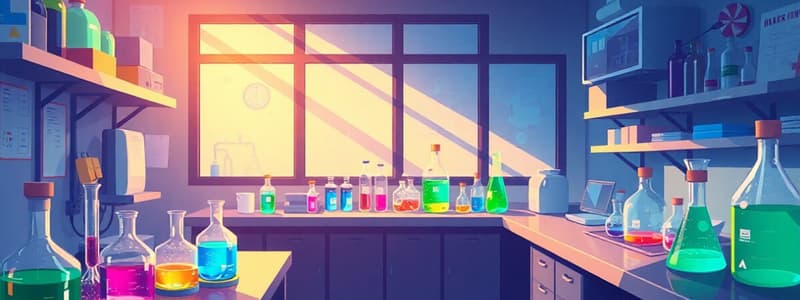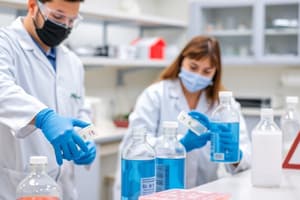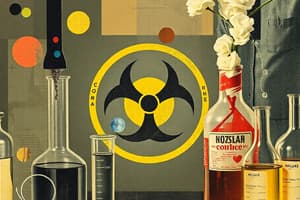Podcast
Questions and Answers
What must students do before working in the chemical laboratory?
What must students do before working in the chemical laboratory?
- Attend a lecture on chemical reactions.
- Sign the safety rules instruction journal. (correct)
- Take a written test on laboratory safety.
- Familiarize themselves with all laboratory equipment.
Which condition automatically excludes a person from working in the laboratory?
Which condition automatically excludes a person from working in the laboratory?
- Being ill or intoxicated. (correct)
- Being untrained in lab procedures.
- Having less than three years of experience.
- Having a previous injury.
What is the procedure to follow if defects are noticed in electrical devices?
What is the procedure to follow if defects are noticed in electrical devices?
- Report defects to a laboratory worker immediately. (correct)
- Continue using them until they malfunction.
- Ignore them if the devices are still operating.
- Try to fix the defects yourself.
Which of these actions can increase the risk of fire in the laboratory?
Which of these actions can increase the risk of fire in the laboratory?
What is the correct action to take when a gas flow is noticed in the laboratory?
What is the correct action to take when a gas flow is noticed in the laboratory?
Under which circumstances is it acceptable to use electrical devices in the laboratory?
Under which circumstances is it acceptable to use electrical devices in the laboratory?
What is required before starting work with laboratory glassware and equipment?
What is required before starting work with laboratory glassware and equipment?
Which of the following is NOT a requirement for electricity safety in the laboratory?
Which of the following is NOT a requirement for electricity safety in the laboratory?
What should be done if an accident occurs in the laboratory?
What should be done if an accident occurs in the laboratory?
What is the maximum amount of flammable solutions allowed to be kept in the laboratory?
What is the maximum amount of flammable solutions allowed to be kept in the laboratory?
Which item is not typically required in every laboratory for safety?
Which item is not typically required in every laboratory for safety?
How should flammable substances and heating devices be handled according to safety protocols?
How should flammable substances and heating devices be handled according to safety protocols?
What type of containers should flammable solutions be stored in?
What type of containers should flammable solutions be stored in?
Which method is effective in extinguishing flaming robes?
Which method is effective in extinguishing flaming robes?
What is the recommended action when working with strong smelling or dangerous substances outside of a fume hood?
What is the recommended action when working with strong smelling or dangerous substances outside of a fume hood?
Which of the following is required on the package of any chemical reagent?
Which of the following is required on the package of any chemical reagent?
What is the correct procedure if no amounts of reagents are indicated?
What is the correct procedure if no amounts of reagents are indicated?
Which of the following statements about personal care in the laboratory is accurate?
Which of the following statements about personal care in the laboratory is accurate?
Which statement is true regarding the use of concentrated acids?
Which statement is true regarding the use of concentrated acids?
When should small amounts of acids or alkaline solutions be disposed of in the sink?
When should small amounts of acids or alkaline solutions be disposed of in the sink?
What should be done when diluting sulfuric acid?
What should be done when diluting sulfuric acid?
What is the safest method to handle volatile substances?
What is the safest method to handle volatile substances?
Why should laboratory dishes not be used for food?
Why should laboratory dishes not be used for food?
What is important to avoid when using a pipette?
What is important to avoid when using a pipette?
What is the recommended action when dealing with a cut caused by glass in a laboratory setting?
What is the recommended action when dealing with a cut caused by glass in a laboratory setting?
In case of acid spilled on oneself, which is the proper method of neutralization?
In case of acid spilled on oneself, which is the proper method of neutralization?
What should a lab worker do immediately if they accidentally ingest a chemical reagent?
What should a lab worker do immediately if they accidentally ingest a chemical reagent?
Which of the following actions is essential for maintaining a safe laboratory environment?
Which of the following actions is essential for maintaining a safe laboratory environment?
When a burn occurs in the laboratory, which initial action should be taken?
When a burn occurs in the laboratory, which initial action should be taken?
What should be done if concentrated sulfuric acid spills on the skin?
What should be done if concentrated sulfuric acid spills on the skin?
What is the incorrect practice regarding the use of a laboratory coat in a lab?
What is the incorrect practice regarding the use of a laboratory coat in a lab?
Which is the recommended method for cleaning up after handling gum in the lab?
Which is the recommended method for cleaning up after handling gum in the lab?
Which chemical formula corresponds to a toxic gas?
Which chemical formula corresponds to a toxic gas?
Identify the chemical that is classified as an aggressive material.
Identify the chemical that is classified as an aggressive material.
Which of the following is classified as a flammable liquid?
Which of the following is classified as a flammable liquid?
What is the correct classification for ammonium hydroxide?
What is the correct classification for ammonium hydroxide?
Which material is specifically categorized for first medical aid?
Which material is specifically categorized for first medical aid?
Which gas is characterized as a flammable gas?
Which gas is characterized as a flammable gas?
Select the compound that is known as an aggressive material and contains sulfate.
Select the compound that is known as an aggressive material and contains sulfate.
Which of the following acids is considered aggressive?
Which of the following acids is considered aggressive?
Flashcards are hidden until you start studying
Study Notes
General Lab Safety Rules
- Only individuals trained in safety procedures and first aid are permitted to work in the chemical laboratory.
- Students must adhere to lab regulations, prioritize personal and colleagues’ safety, and follow instructions.
- Defective equipment must be reported to the lecturer and not used.
- Ill and intoxicated persons are prohibited from working in the lab.
- Laboratory work is only allowed when gas and electricity systems are operational, and the fume hood is functioning correctly.
- Smoking is restricted to designated areas.
- Electrical devices must be operated according to the manufacturer's instructions.
- Damaged electrical components, like sockets, plugs, and switches, should not be used.
- Electrical devices must be grounded when required by the operational rules.
- Electrical devices should be switched off if current flow is detected outside the circuit.
- Multiple high-power devices should not be connected to a single socket if their combined current exceeds the capacity of the installation cables.
- Electricity distribution boards need to be locked.
- Fixing electrical devices connected to the circuit is forbidden.
- Voltages up to 36 volts are generally safe for humans.
- Treat laboratory equipment, glassware, and devices with care and only use them after proper training.
- Report any equipment damage to the laboratory worker immediately.
- Laboratory assistants must check device connections before usage.
- Report any defects in gas, water, drainage, or electrical systems to the laboratory worker.
- In case of gas leaks, close the gas valve, and avoid switching on any devices that may spark or ignite a flame.
- Before leaving the laboratory, ensure all electrical and gas devices are switched off, and there are no leaks in water or gas systems. The last person leaving is responsible for this task.
- Each laboratory must be equipped with a first aid kit, a fire extinguisher, a woolen blanket, resin gloves and shoes, an insulating resin carpet, and protective glasses.
- In case of an accident, provide first aid to the injured person, and call emergency services (112) if necessary.
- Report accidents to the lab leader and preserve the accident site as it was, unless it poses a danger to people. Note any required changes in the incident report.
- Always wear a clean laboratory coat while working.
- Wash hands thoroughly with warm water and soap before and after work. Use disinfectants and neutralizing measures.
- Avoid keeping food in the working area; eat only in designated zones.
Handling Reagents and Devices
- Flammable solutions must be stored in thick glass containers with polished corks. These containers should be kept in metal boxes lined with asbestos.
- The laboratory should not store more than 3 liters of flammable solutions.
- Only one gas cylinder is allowed in the laboratory.
- The remaining pressure in the gas cylinder must be at least 0.5 kg/cm3 after use.
- Bromine, phosphorus, alkali metals, and concentrated acids must be stored in a secure location, safely accessible in case of fire.
- Chemical reagent packages must be labeled with the substance name and purity.
Working with Hazardous Substances
- Experiments involving strong-smelling, explosive, volatile, or hazardous substances must be carried out in the fume hood with the protective glass lowered.
- When working with strong-smelling, dusty, or hazardous substances outside the fume hood, wear a respirator mask and safety glasses.
- The individual preparing a new experiment or laboratory work is responsible for its safety.
- Handle flammable substances and heating devices with extreme caution. Do not heat ether (C2H5-O-C2H5), ethanol (C2H5-OH), or petroleum (C5-C9) using an open flame or an open electrical heater. Heat them gradually using a closed electrical cooker or a water bath.
- Extinguish fires involving flammable volatile substances, active metals, or burning substances with sand. Do not use water.
- Extinguish fires on clothing or other surfaces by wrapping them in a woolen blanket.
Performing Chemical Experiments
- Use the exact amount of substances specified in the laboratory work instructions for each experiment.
- If the reagent amounts are not specified, do not weigh or measure them, but do not exceed half the volume of the tube or reaction dish.
- If the acid or alkaline solution concentrations are not specified, only use diluted reagents.
- Ensure that reagent bottles are sealed with the same corks and returned to their designated locations after use.
- Use clean pipettes or paddles to avoid contaminating reagents.
- Do not pour unused reagents back into their original containers.
- When diluting sulfuric acid, always add the acid to the water, never the other way around.
- Mix solutions by shaking the tube, not by closing it with your finger and inverting it.
- After using concentrated acids, alkaline solutions, strong-smelling, or aggressive reagents, dispose of them in designated containers, not the drain. Neutralize them before disposal (acids with calcium hydroxide Ca(OH)2 or calcium carbonate CaCO3, alkaline solutions with acids).
- When small amounts of acids, alkaline solutions, strong-smelling, or aggressive reagents are discarded into the sink, flush them with a large volume of water.
- Silver (Ag) and other expensive reagents should be collected in designated containers.
- When heating solutions, point the open end of the tube away from people.
- Use a rubber bulb to draw out solutions from pipettes, avoid drawing them by mouth.
- Do not draw concentrated acids or alkaline solutions by mouth. Always use a rubber bulb.
- Do not test the properties of reagents by tasting; all reagents are poisonous!
- When smelling volatile substances, carefully direct the air towards yourself using a hand wave.
- Do not use laboratory glassware for eating, drinking, or storing food products.
- Use only clean glassware for chemical experiments. Wash glassware immediately after use.
- Do not store alkaline solutions in containers with polished corks.
- Only insert a rubber hose onto a glass tube after moistening it with water or applying a thin layer of petroleum jelly or glycerol C3H5(OH)3. Hold the glass tube wrapped in a towel when inserting the hose.
- Cut rubber tubing only with a sharp knife moistened with water or smeared with glycerol. When drilling a rubber cork, smear the drill with petroleum jelly or glycerol.
- When corking a container, hold the container close to the opening.
- When pouring liquid from a bottle, keep the label facing upwards to prevent smudging.
- Maintain a clean work area and immediately clean any spilled reagents or contaminants.
- Keep your notebook in a drawer to prevent contamination with chemical reagents.
- Wear a laboratory coat in the chemical laboratory. Put on the laboratory coat before entering the laboratory and take it off after leaving.
Actions in Emergency Cases
- In case of poisoning, injury, or fire, inform lab personnel and call emergency services (112).
- If cut by glass, remove glass fragments from the wound, treat it with iodine, and bandage it.
- If acid spills on you, wash the affected area with a large amount of water and neutralize it with a 1-3% baking soda (NaHCO3) solution.
- If concentrated sulfuric acid (H2SO4) spills on you, clean the affected area with paper or cloth, then wash it and neutralize it.
- If alkaline solutions spill on you, wash the affected area with a large amount of water and neutralize it with an acetic acid (CH3COOH) solution or a saturated boric acid (H3BO3) solution.
- If a reagent accidentally enters your mouth, immediately spit it out, rinse your mouth with water, and use neutralizing solutions (baking soda, boric or acetic acid).
- Treat a burn with cold water and bandage it.
- If you are intoxicated by chlorine (Cl2), hydrogen sulfide (H2S), or other substances via respiratory system, bring the patient to fresh air, provide them with ammonia to smell, and apply a cold compress to their neck or chest. If necessary, administer artificial respiration and heart massage.
- If bromine (Br2) comes into contact with the skin, wash the affected area with ethanol or petroleum ether, smear it with glycerol, and bandage it.
- First aid supplies are available in the laboratory's drugstore.
Main Materials of Chemical Laboratory
- Acetone (CH3COCH3): Flammable liquid
- Acetic Acid (CH3COOH)
- Ammonia (NH3): Flammable aerosol
- Ammonium hydroxide (NH4OH)
- Ammonium sulfate [(NH4)2SO4]
- Carbon dioxide (CO2)
- Carbon monoxide (CO): Toxic gas
- Carbonic acid (H2CO3)
- Nitric acid (HNO3): Aggressive material
- Barium hydroxide (Ba(OH)2): Aggressive material
- Petroleum (C6H14...C10H22): Flammable liquid
- Borax (Na2B4O7 · 10H2O)
- Boric acid (H3BO3): First aid material
- Butane (C4H10): Flammable gas
- Chlorine (Cl2): Toxic gas
- Hydrochloric acid (HCl): Aggressive material
- Ethane (C2H6): Flammable gas
- Ether (C2H5OC2H5): Flammable liquid
- Ethyl alcohol (C2H5OH)
- Orthophosphoric acid (H3PO4): Aggressive material
- Phosgene (COCl2): Toxic gas
- Glycerol (C3H5(OH)3): First aid material
- Iodine (I2): First aid material
- Calcium hydroxide (Ca(OH)2): Aggressive material
- Calcium carbonate (CaCO3)
- Calcium oxide (CaO): Aggressive material
- Potassium dichromate (K2Cr2O7)
- Potassium carbonate (K2CO3)
- Potassium permanganate (KMnO4): First aid material
- Potassium hydroxide (KOH): Aggressive material
- Crystal soda (Na2CO3 · 10H2O)
- Methane (CH4): Flammable gas
- Sodium chloride (NaCl)
- Sodium hydroxide (NaOH): Aggressive material
- Sodium bicarbonate (NaHCO3): First aid material
- Propane (C3H8): Flammable gas
- Sulfuric acid (H2SO4): Aggressive material
- Hydrogen sulfide (H2S): Toxic gas
- Soda (Na2CO3): Aggressive material
Studying That Suits You
Use AI to generate personalized quizzes and flashcards to suit your learning preferences.




